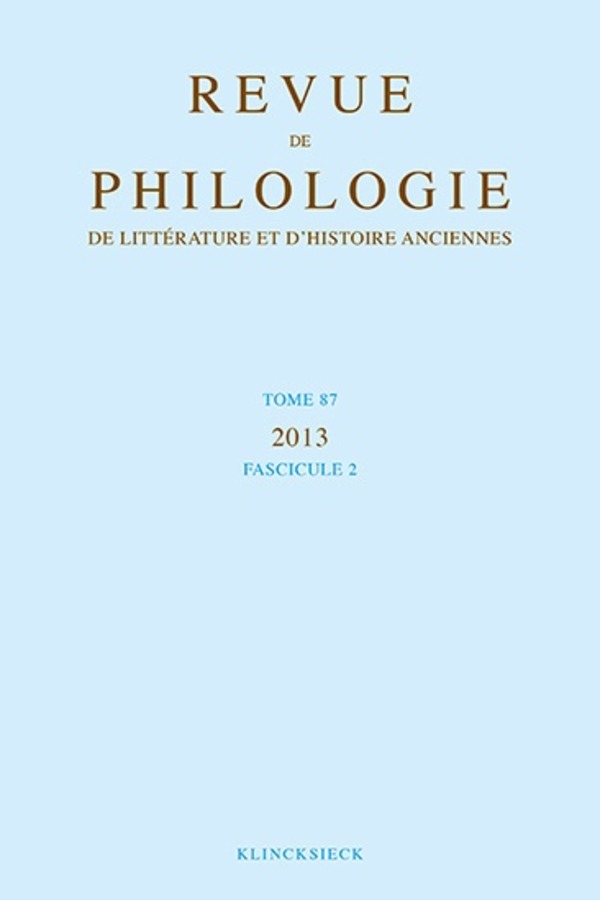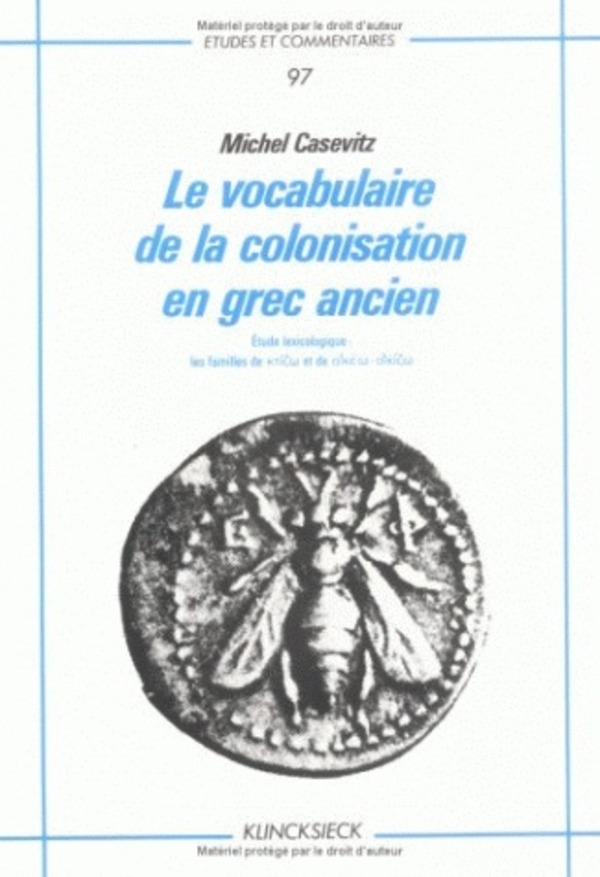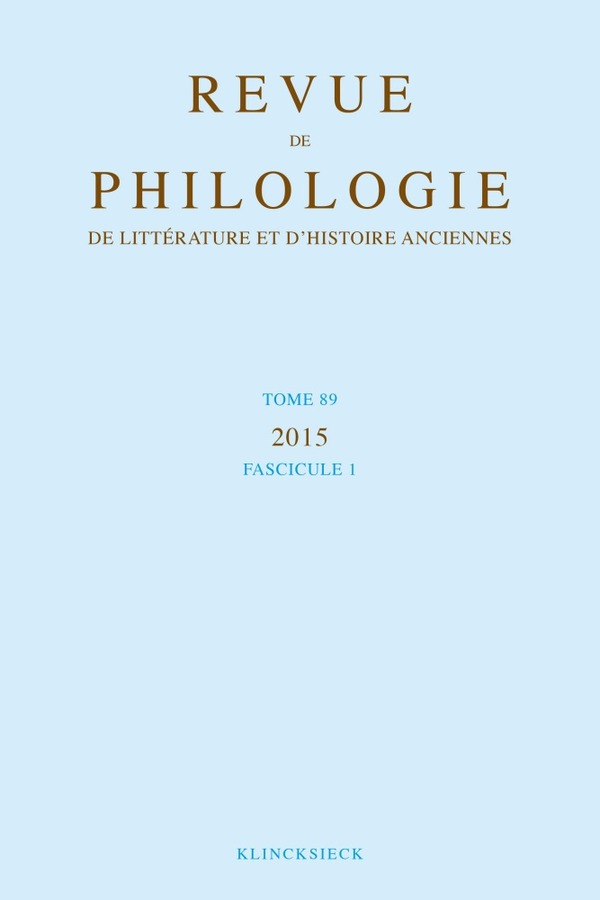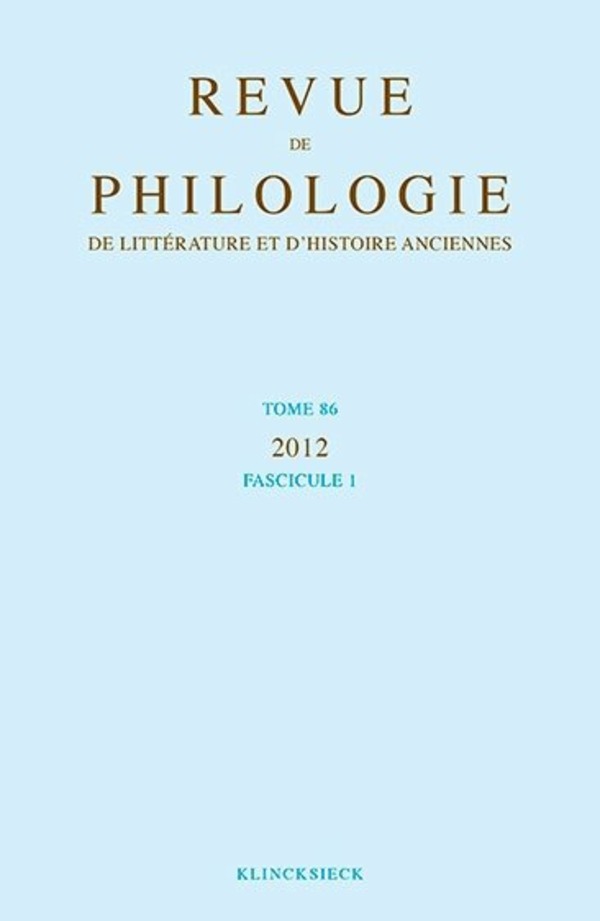Revue de philologie, de littérature et d'histoire anciennes volume 87
Fascicule 1
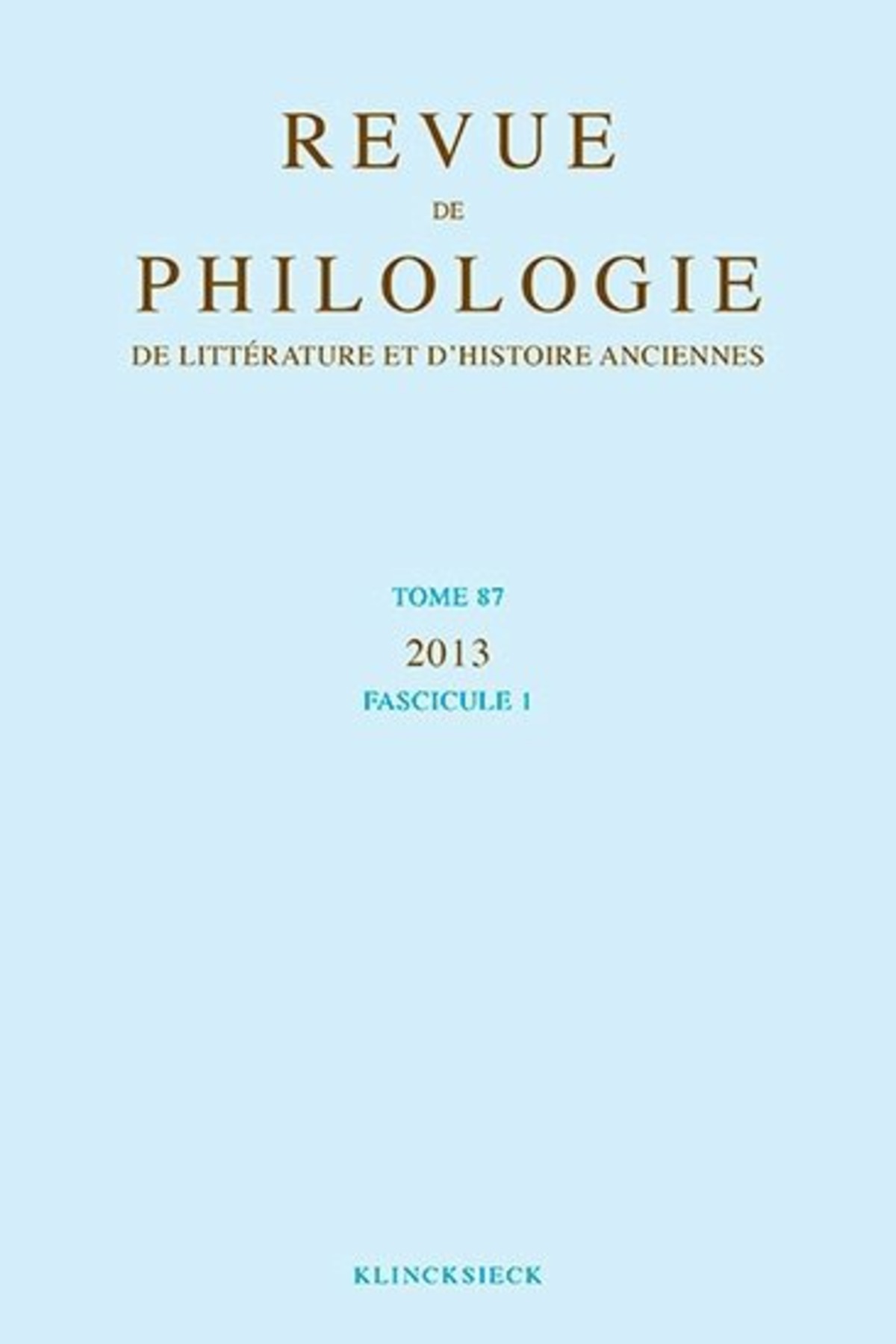
- 202 pages
- Livre broché
- 15.8 x 24 cm
- Revue de philologie, de littérature et d'histoire anciennes
- Parution : 20/02/2015
- CLIL : 3439
- EAN13 : 9782252039601
- Code distributeur : 49992
Présentation
Sophie AUBERT-BAILLOT. – Une singularité rhétorique : la vertu stoïcienne de l'élaboration (κατασκευή) (p. 7-26)
Définie comme « l'expression qui consiste à éviter la trivialité », la κατασκευή stoïcienne est une vertu du discours originale, qui semble être née dans un contexte aristotélicien, théophrastien plus exactement, où elle revêtait le sens d'« ornementation », jusqu'à ce que le Stoïcien Diogène de Babylonie lui fît subir un infléchissement en se réclamant notamment de la pensée socratique du Gorgias. Entendue dans son sens premier comme « constitution » et disposition élaborée de l'expression, elle désigne en un deuxième sens l'« entraînement ». Cette « ascèse » (παρασκευή) stylistique a pour corollaire l'idée d'« équipement », en l'occurrence d'un arsenal rhétorique destiné à favoriser une triple adaptation du discours – au thème traité, puis à l'orateur, muni des outils lui permettant de faire face à toutes les circonstances, et enfin à l'auditoire, qu'il ne faut incommoder ni par un langage relâché ni par des déficiences techniques et un manque de préparation. L'acception d'« ornementation » naît de ce passage d'une définition restrictive – le rejet de tout ἰδιωτισμός – à une élaboration stylistique envisagée de manière positive, tournée vers l'efficacité et l'agrément (au double sens d'accord et de plaisir) du public.
Sophie AUBERT-BAILLOT. – A singular virtue in rhetoric: Stoic elaboration of speech (κατασκευή) (p. 7-26)
Defined as "the expression which consists in avoiding triviality", Stoic κατασκευή is a stylistic virtue that is quite original. It seems to be born in an Aristotelian, or more precisely Theophrastean, context, where it meant “ornamentation”, until it was altered by the Stoic Diogenes of Babylon, himself under the influence of Socratic thought as it is developed in Plato's Gorgias. Its original meaning being “constitution”, the word κατασκευή refers to an elaborate stylistic disposition, or mode of expression. Its second meaning, “training”, is akin to stylistic ascesis (παρασκευή) and implies the idea of “equipment”, i.e. of a rhetorical arsenal designed to promote a threefold adaptation of speech – first to the topic, then to the speaker, endowed with the necessary tools to face every kind of circumstances, and finally to the audience that an orator should not bother with a loose speech or with technical deficiencies and a lack of preparation. The meaning of “ornamentation” stems from this shift between a restrictive definition (the rejection of any ἰδιωτισμός) to a stylistic elaboration thus considered positively, that is efficiency-oriented, creating both a sense of agreement and pleasure among the audience.
Marie AUGIER. – Sur le sens de διακόρευσις dans un règlement du IIIe siècle après J.-C. de l'île de Rhodes (p. 27-36)
Cette étude porte sur le terme διακόρευσις, qui apparaît dans un règlement de Rhodes contenant des prescriptions cathartiques (Blinkenberg, Lindos II, n° 487). L'analyse revient tout d'abord sur l'interprétation que Franciszek Sokolowski avait donnée du terme dans son Supplément de 1962 (n° 91). Il lui avait donné le sens de « viol de jeune fille » et non celui de « défloration », alors même que ce terme est un hapax dans la documentation épigraphique et qu'il apparaît dans une suite de prescriptions cathartiques peu explicites. Pour tenter de comprendre ce que pouvait signifier ce terme, l'étude s'appuie sur le contexte réglementaire dans lequel il a été employé, sur l'analyse du mot et sur les mentions du terme dans d'autres types de documents, tels que les traités de médecine ou les récits.
Marie AUGIER. – On the meaning of διακόρευσις in a third century CE regulation from Rhodes (p. 27-36)
This paper deals with the meaning of the word διακόρευσις in an inscription from Rhodes which contains purity regulations (Blinkenberg, Lindos II,
n° 487). The analysis reconsiders first Franciszek Sokolowski's interpretation in his Supplément (1962, n° 91). In his view, the term positively refers to the rape of a girl and not to her deflowering, even though it is a hapax in epigraphic documents, occurring in a list of purity regulations which are not clear. In order to grasp the meaning of the term, this study relies on the very context of the regulation in which it is used of the word itself, and on the mentions of the term in other documents, such as medical treatises or narratives.
Francesca Romana BERNO. – Avere la morte fra le mani. Nota a Sen., Epist. 51, 9 (p. 37-40)
In Sen. Epist. 51, 9 (Quo die illam [sc. fortunam] intellexero plus posse, nil poterit : ego illam feram, cum in manu mors sit ?), alcuni editori stampano illam, altri illa me : quest'ultima scelta mi sembra preferibile, perché intellego presuppone un ragionamento, mentre il fatto che la sorte sia più potente degli uomini è ovvio. Al termine del periodo, un punto fermo mi sembra più opportuno di un punto interrogativo : ferre fortunam in Seneca ha il senso positivo di sopportare e superare le avversità, e in manu esse allude al suicidio come forma estrema di lotta e vittoria contro la sorte. Dunque, queste proposizioni vanno intese come esplicative di quanto precede in senso affermativo, e non interrogativo o di interrogazione retorica.
Francesca Romana BERNO. – Having Death at Hand: A Note to Sen. Epist. 51.9 (p. 37-40)
In Sen. Epist. 51.9 (Quo die illam [sc. fortunam] intellexero plus posse, nil poterit: ego illam feram, cum in manu mors sit?), editors print either illam or illa me: illa me seems more convincing, since the verb intellego implies the result of a reasoning, while the fact that fortune is more powerful than men is obvious. At the end of the sentence, it would be better to insert a full stop rather than a question mark: ferre fortunam in Seneca means “to bear” in a positive sense, viz. “to get over misfortune”; in manu esse alludes to suicide as a supreme form of victory against fate, so the two propositions explain the previous sentence in a positive, and not in an interrogative (or rhetorically interrogative) way.
Éric DIEU. – L'étymologie de l'adjectif grec θεσπέσιος (p. 41-59)
L'adjectif grec θεσπέσιος, « divin, extraordinaire, merveilleux, prodigieux », repose sur un composé dont le second membre a pu être rattaché soit au groupe de ἐννέπω « raconter, annoncer, proclamer », selon l'analyse traditionnelle, soit à une racine *speh1- « engraisser ; réussir, aboutir, arriver à », suivant une étymologie proposée par M. Meier-Brügger. Le présent article s'efforce de montrer, par un examen des occurrences les plus anciennes de cet adjectif dans la littérature grecque, que l'étymologie traditionnelle doit être préférée.
Éric DIEU. – Zur Etymologie von griechisch θεσπέσιος (p. 41-59)
Das griechische Adjektiv θεσπέσιος „göttlich, übermenschlich, gewaltig, wundervoll“ beruht auf einer Zusammenbildung von θεσ- und einem Hinterglied, das entweder mit der Sippe des Verbums ἐννέπω „ansagen, erzählen, verkünden“ verwandt ist, wie es gemeinhin angenommen wird, oder von einer idg. Wurzel *speh1- „gedeihen, sich ausdehnen; vorwärtskommen, Erfolg haben, gelingen“ stammt, wie M. Meier-Brügger es vorgeschlagen hat. Im vorliegenden Aufsatz legt eine philologische Diskussion die Annahme nahe, daß die traditionelle Hypothese wahrscheinlicher ist.
Mathieu ENGERBEAUD. – La Bataille d'Ausculum (279 av. J.-C.), une défaite romaine ? (p. 61-80)
Les différents récits conservés de la bataille d'Ausculum (279 av. J.-C.) présentent un paradoxe. Cet affrontement, qui oppose l'alliance des Romains à celle du roi Pyrrhus, est célèbre dans l'Antiquité. Cependant, les treize sources littéraires qui mentionnent la bataille présentent des versions contradictoires de l'issue du combat. Ces témoignages racontent en effet aussi bien la victoire du roi d'Épire que celle des Romains. Malgré ces versions divergentes, la bataille est traditionnellement considérée par les historiens comme un nouveau succès de Pyrrhus contre les Romains, succédant à sa victoire d'Héraclée un an plus tôt. Cependant, une réévaluation des différentes versions de cette bataille pourrait permettre de nuancer l'idée même de défaite romaine à Ausculum.
Mathieu ENGERBEAUD. – The Battle of Ausculum (279 BCE), a Roman defeat? (p. 61-80)
A paradox lies within the various accounts of the 279 BCE Battle of Ausculum. This confrontation, which pitted Rome and its allies to the forces of King Pyrrhus, was famous in Antiquity. Notwithstanding its fame, the outcome of the fight gave way to various and even contradictory accounts, as is evidenced by the comparison between the thirteen literary sources that relate these events. Some of them present the battle as being won by King Pyrrhus, and others as a Roman victory. In spite of these divergent versions, the battle is traditionally considered by the historians as a new success of Pyrrhus against the Romans, after his previous victory in Heraclea one year earlier. A cross-reading of the various versions of this battle leads us to reconsidering the context and the way in which the idea of a Roman defeat in Ausculum may have originated.
Antoine FOUCHER. – L'hiatus interlinéaire dans les élégies de Tibulle (p. 81-105)
Cet article se propose d'étudier l'hiatus interlinéaire dans les élégies de Tibulle, aux deux niveaux possibles du distique élégiaque : à la fin de l'hexamètre ou bien à la fin du pentamètre. L'examen, d'abord prosodique, puis métrique et syntaxique et enfin stylistique, du phénomène révèle la façon dont Tibulle conçoit l'architecture du distique, dont la complexité est plus grande qu'il n'y paraît.
Antoine FOUCHER. – Interlinear hiatus in the Elegies of Tibullus (p. 81-105)
The aim of this paper is to study the interlinear hiatus in the elegies of Tibullus, which can intervene at two possible places in the elegiac distich: at the end of the hexameter or at the end of the pentameter. The study of this phenomenon, firstly on a prosodic level, then on a metrical, syntactic and finally stylistic level, sheds new light on Tibullus' various and complex approaches to the architecture of the elegiac distich.
Sébastien MORLET. – La Préparation évangélique d'Eusèbe et les Stromates perdus d'Origène : nouvelles considérations (p. 107-123)
Deux nouvelles considérations permettent d'étayer l'hypothèse, proposée par H.D. Saffrey en 1975, puis par l'auteur en 2004, d'un emprunt aux Stromates d'Origène dans la Préparation évangélique d'Eusèbe (livres XI-XII) : 1) le chapitre sur le nom divin (XI, 12) présente des parallèles avec la façon dont Origène parle du tétragramme ; 2) le développement sur la justesse des noms hébreux (XI, 6) contient des éléments qui orientent vers une source origénienne.
Sébastien MORLET. – Eusebius' Praeparatio evangelica and Origen's lost Stromateis: a reconsideration (p. 107-123)
Two new observations lead to sustain the hypothesis, first suggested by H.D. Saffrey in 1975, then by the author in 2004, that Eusebius' Praeparatio evangelica (books XI-XII) were influenced by Origen's Stromateis: 1) the chapter on the divine name (XI, 12) echoes the way Origen speaks about the tetragrammaton; 2) the exposition on the appropriateness of Hebrew names (XI, 6) contains elements which lead back to an originenian source.
Yann RIVIÈRE. – L'interdiction de l'eau, du feu… et du toit (sens et origine de la désignation du bannissement chez les romains) (p. 125-155)
L'enquête vise à saisir le sens et l'origine de l'ancienne formule de bannissement chez les Romains. Employée, selon la légende, pour la première fois par Romulus (D.H. 2, 53, 1), elle n'est pas attestée historiquement avant un procès comitial tribunicien pour crime contra rem publicam daté de l'année 212 av. J.-C. (Liv., 25, 4, 9), tandis que le plus ancien document qui la mentionne est une satire de Lucilius (Lucil., Sat. 29 C. = 787M). Ce texte insère la formule dans une représentation cosmique unissant les quatre éléments (l'eau, le feu, la terre et l'air). Certaines interprétations ont été proposées par les Anciens, (notamment P. Fest., p. 3, L) qui permettent de rapprocher le bannissement d'autres rites de franchissement, de séparation ou de délimitation où sont convoqués l'eau et le feu. Comment comprendre alors l'introduction (provisoire sans doute) d'un troisième terme, avec l'interdiction du « toit » apparue au dernier siècle de la République, au cours des guerres civiles ? Sans doute faut-il la mettre en rapport avec une limitation de l'hospitium. Ces questions lexicales peuvent contribuer à éclairer les différents contextes procéduraux dans lesquels la formule est employée. Encore présente dans les sources du début du Haut-empire, elle disparaît à partir de l'époque sévérienne où elle est explicitement remplacée par le terme deportatio.
Yann RIVIÈRE. – The interdiction from water, fire… and roof (meaning and origin of the designation of banishment by the Romans) (p. 125-155)
The inquiry aims to understand the meaning and the origin of the old formula of banishment by the Romans. Used for the first time, according to the legend by Romulus (D. H. 2, 53, 1), it is not historicaly attested before the comitial tribunician process for crime contra rem publicam in 212 BCE (Liv., 25, 4, 9), and its most ancient attestation is a satire of Lucilius (Lucil., Sat. 29 C. = 787M). This text inserts this formula in a cosmic representation in which the four elements are mentioned (the water, the fire, the earth and the air). Some interpretations of such a designation were proposed by the Romans, (especially P. Fest., p. 3, L) : these brief commentaries contribute to put the banishment together with other rituals of “transition”, “delimitation” or “separation”, in which the fire and the water are used. How can we understand the introduction (provisional, as it seems) of a third term, that is the interdiction from “roof” which seems to appear in the course of the last century of the Republic, during the civil wars? Maybe it could be linked to the limitation of the hospitium. These question of vocabulary may enlight the different contexts of procedure where this formula appears. It is always employed at the beginning of the High Empire, then it disappears from the Severan period onwards, when the jurists decide to replace it with the word deportatio.
Pierre VESPERINI. – Marc Aurèle, la « vérité héroïque » et la mélancolie (p. 157-172)
Marc Aurèle emploie dans ses écrits (III, 12) une expression, « vérité héroïque » (ἡρωϊκὴ ἀλήθεια), difficile à comprendre. Faute de rapprochements probants, plusieurs savants ont donc modifié le texte. Cet article propose une élucidation de cette expression à partir d'un nouveau rapprochement : un mot de Favorinus cité par Aulu-Gelle, où l'on voit d'une part que la vérité désigne ici le franc-parler de la παρρησία, et, d'autre part, que ce qui lie la condition héroïque au franc-parler, c'est la constitution mélancolique.
Pierre VESPERINI. – Marcus Aurelius, “heroic truth” and melancholy (p. 157-172)
In his writings (III, 12) Marcus Aurelius uses an expression, “heroic truth” (ἡρωϊκὴ ἀλήθεια), which is uneasy to understand, mostly for want of convincing parallels. Therefore some scholars modified the text.
This article proposes to solve the riddle thanks to a new parallel: a quote from Favorinus in Aulus Gellius. It shows that “truth” here means the “frank speech” of παρρησία, and that what links a heroic condition to sincerity is a melancholic constitution.

